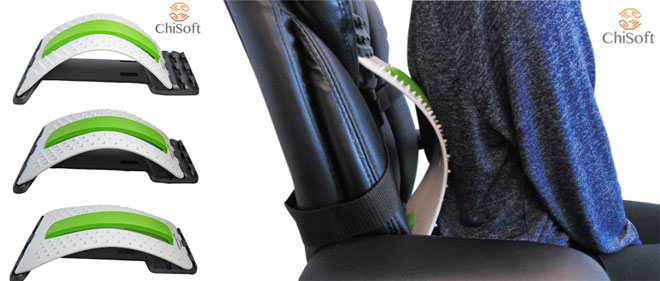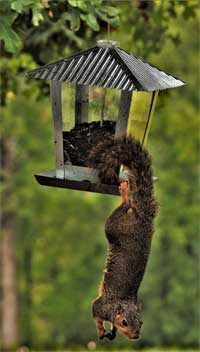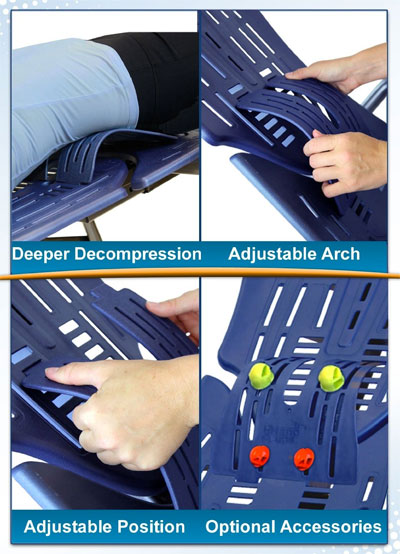Can a cheap, curved plastic device really work to fix back pain? We take a look at the Upside Down Back Stretcher to find out how and why it works. And, if you should get one.

ChiSoft Back Stretcher with Lumbar Support
Is An Upside Down Back Stretcher Just a Cheap Plastic Toy?
Back Stretchers are handy, inexpensive devices that can help alleviate chronic lower back pain by relieving tension and improving posture. Yes, they do look like a cheap plastic toy that would never work, and many people dismiss them for that very reason.
How Do You Know that You Need to Stretch Your Back?
 The fact is that improving our posture, flexibility and core strength can be all that is needed to relieve pain. These simple adjustments can prevent back aches in the future as well.
The fact is that improving our posture, flexibility and core strength can be all that is needed to relieve pain. These simple adjustments can prevent back aches in the future as well.
The key comes down to daily treatment and care. The changes we make don’t need to be big or take a lot of time. However, we do need to be consistent.
Having said that, just like chronic pain issues usually take years to develop, reversing the damage is usually not instant. Small tweaks can go a long way as long as long as we don’t give up shortly after we start.
Where Did My Back Pain Come From?
Most of us sit for long periods of time during the day, whether is is at a desk all day long, sitting through long daily commutes or on a sofa in the evening watching tv. Even if we regularly workout an hour at the gym everyday, this sedentary lifestyle an take a toll on our bodies.
We are constantly using our back muscles as we move throughout the day. If you’ve ever thrown out your back or injured it, you realize exactly how much even minor pain can affect your day.
Is There an Affordable, Effective Solution to Back Pain?
In a perfect world, we could push a button and the pain would disappear. In a less-than-perfect world, we would be able to increase the flexibility in our backs, strengthen our muscles, improve our posture and get rid of chronic pain.
The solution would need to be cheap, convenient and easy to use and portable so we can use it wherever we go. It would need to be comfortable and relaxing to use so that we enjoy using it on a daily basis.
Well, that brings us back to the back stretcher… that cheap plastic toy. Or is it?
Note: In addition to stretching, moving and staying strong, WebMD recommends that we make our workspaces ergonomically correct. We can find lots of expensive ergonomic chairs for sale. However, I find it interesting how an inexpensive back stretcher can essentially provide that same lumbar support. Try one out for $25.
Another popular model includes the Magic Back Lumbar Support Stretcher. Typically, people use this as a massage device due to its built-in acupressure nodes. That said, an Arched Padded Back Stretcher works better if you prefer something that feels more like a cushion rather than a curved piece of hard plastic.
In any case, all three of these devices can stretch out your back while you sit at your office desk. Plus, you can use it when driving in your car, relaxing on the sofa or laying on the floor. No, you don’t need to use them all day long. In fact, some people use them in short sessions interspersed throughout the day.
Upside Down Back Stretcher Review:
However, back stretching is not just about sitting around. Thats’ right, you can use one while you are inverted as well. Of course you knew I was going to say this, right?
 I didn’t come up with this idea, though. Teeter Hang-ups already developed this solution for their inversion tables called the “Lumbar Bridge“. It comes as a separate accessory that fits directly on the bench. You can even attach acupressure nodes to it.
I didn’t come up with this idea, though. Teeter Hang-ups already developed this solution for their inversion tables called the “Lumbar Bridge“. It comes as a separate accessory that fits directly on the bench. You can even attach acupressure nodes to it.
The theory behind the upside-down back stretcher is that we can achieve a deeper decompression while we are inverted. The body is already stretching out anyway due to gravity, right?
You don’t need to buy the Teeter Hang-ups table to put this idea into action yourself. Do you already have an inversion table and want to get one of the back stretchers above? Then you can use them with the table you already have. The only drawback is that these aren’t designed to attach snugly to the table and therefore may slip around. I’d suggest doing a partial inversion.
